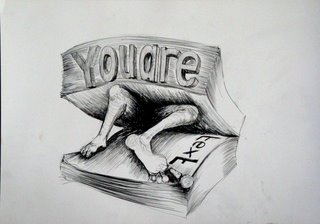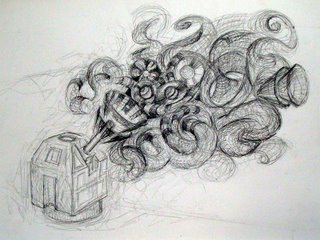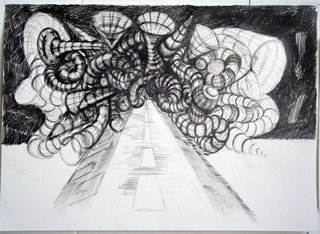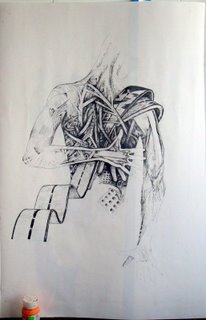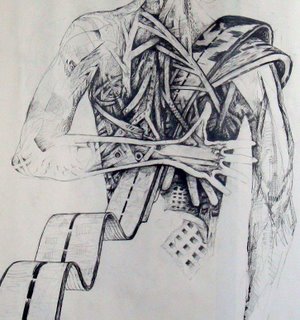The German Drawing
This theme may sound strange. The idea came from a discussion with Tilman and Libuse about the paintings of Neo Rauch. For both Tilman and me these were "new" and "strange". For Libuse, coming from the same culture area as Neo Rauch, the East German and the Czech before the fall of the iron curtain, these images were too familiar to be impressive.
This differences between experience and viewpoints of individuals is nearly lost in temporary art. All art seems to be global. Art made in Japan or in Bremen, it has the same subjects and the same esthetics. So art is nowadays rooted in the global aspects of the human being. The joy, the suffering and the feelings inbetween that apparently belong to everyone in the world. Maybe we have to differentiate: everyone in the Western culture influence of the world. Modern Art still is typically Western.
Neo Rauch is very appreciated (by artists) and he presents a "local" image of his youth. Images also from a culture which has disappeared. Just this difference from "main stream" is very appealing. Along comes Libuse and she demonstrates that indeed this local - global difference about art is in play. I was not very conscious of the fact of Neo Rauch using east german imagery, although i recognized some of it.
I think his paintings also convey more feeling than global art. Global art is rather cold and very "arty". (Arty being a state in which the things says: "i am very much modern art".)
Ok so i was looking for the local aspect. Is it still possible to make "local" art. What does it mean?
What makes art local?
Therefore the theme German Drawing.
What can be German for Tilman, and what can be German for me. Can we resolve German to standardized feelings? German being something related to the Second World War, or worn out ideas about Germans? What has Tilman as a German to say about this (in drawing)?
And what is Dutch: folkloristic dresses, wooden shoes, tullips??? Or rationality, being very commercial, dogmatic in religion? Freedom of speech and hospitality?
What do I feel: being Dutch? Or just plain human.
Is Mondrian Dutch, because his lines ressemble the straightness of the country and the spirits of the people? Is Ruysdael Dutch because he depicted the transparencies of the skies so well?
Some of the "spirits" of the people seems to lie in the past. In history. In the history of their painting. The seascapes of the 17th century with the abundance of grey, skies and water are examples.
Sometimes an artist on their own put down a "local" identity, like Michelangelo, Goethe, Tarkoskij, Dumas. They seem to invent and express exactly some deep feelings about their nationality. Modern movies from "developing" countries can have the same very deep aspect of the culture they come from. Can have, because as often movies are in the domain of the "global".
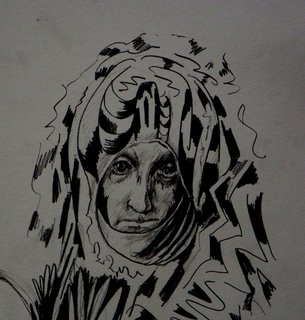
Also expressing feeling like a Russian, by Tarkosvkij also involves modern (global) sentiments. He actually includes news reels of the war in his movies.
In the West the second "Revolution", after the French in 1789, was 1968. This was an international event, but at the same time a very local event in human feeling. Fuelled by the abstinations of the aftermath of the war and new inventions it became a call for "the human", love and compassion, a protest against the lack of feeling of the period after the war.
Then this flash of the vital, the free and the new was past. The only thing left the pop songs from that time and the everlasting rockmusic.
Tilman belonged to the German youth participating in this 1968 movement. For me as a Dutch this 1968 is more French.
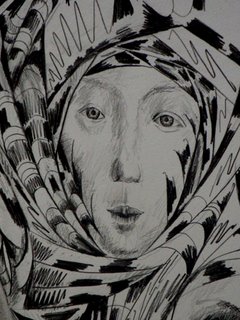
For me this theme "A german Drawing" has more and more become a thinking exercise. This locl aspect seems to be situated in "fuzzy" diffuse thinking. When an artist depicts a cloud a metereorologist always points out that this art- cloud says nothing about the "real" cloud. (Comments on the (very Dutch) paintings of Vermeer.)
My temporary conclusion is that if art can display the local, this local must already be history. It must certainly be fuzzy, for instance our Western view of the real Russian tragic feeling about their counntry. It must be made by an artist from this local region, but in diaspora, like Tarkovskij in Italy.
What then could be German, for a Dutch?
First of all a Dutch can never make drawings with a German feeling. A Dutch person could only make, and is forced to make "Dutch" drawings, for instance working (and lost) for instance in China, or Japan, for years.
Being away from your "roots" some deep feeling could maybe be distracted - if the artist feels like it. If she has a tendency for these kind of nostalgic feelings.
Nowadays, the Western world having more and more global aspects these mindscapes seem to be diminishing. On the other hand the native language is so powerfull. Being in Germany already i cannot really express myself anymore like i would have liked in Dutch, although i can make myself perfectly clear. So I think language is a great upkeeper of the local. Logically the visual arts, mainly without language, or without the subtile part of it, are more free, and more apt to be "global". The local should be found more in literature, and indeed, although a lot is translated, i know texts, German texts, which cannot be translated in other languages, in none, without lossing 60% of their meaning.
How am i going to fulfill my own theme of making a German drawing????
I cannot.
I present some drawings of persons i found in "old German art". Durer for instance, but also other anonymus art from 15 and 16 century. I think people from that age look different. (See how fuzzy i reason?) They are more "fromm", inwardly orientated. There was more a tendency to look inwards then outwards. This feeling i situate in Germany. I realize that for Tilman this cannot be other than absurd!!!
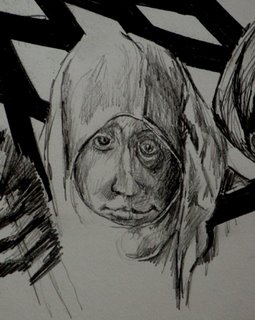 details from a larger drawing
details from a larger drawing
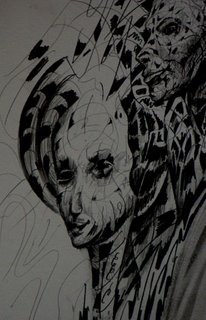
And to proove this "German" feeling wrong immediately i finish with a drawing of a lady on the BierFesten im Oktober in and around Munchen. Very traditional and a rather outward looking face!
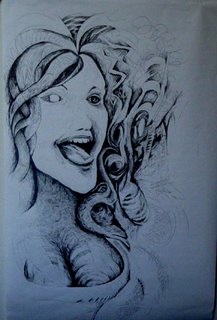 To be really finishing with a sketch of a person collecting dangerous garbage: he seems to wear the tradtional Dutch wooden shoes....
To be really finishing with a sketch of a person collecting dangerous garbage: he seems to wear the tradtional Dutch wooden shoes....
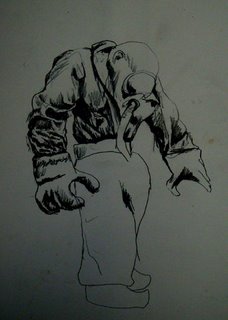
This differences between experience and viewpoints of individuals is nearly lost in temporary art. All art seems to be global. Art made in Japan or in Bremen, it has the same subjects and the same esthetics. So art is nowadays rooted in the global aspects of the human being. The joy, the suffering and the feelings inbetween that apparently belong to everyone in the world. Maybe we have to differentiate: everyone in the Western culture influence of the world. Modern Art still is typically Western.
Neo Rauch is very appreciated (by artists) and he presents a "local" image of his youth. Images also from a culture which has disappeared. Just this difference from "main stream" is very appealing. Along comes Libuse and she demonstrates that indeed this local - global difference about art is in play. I was not very conscious of the fact of Neo Rauch using east german imagery, although i recognized some of it.
I think his paintings also convey more feeling than global art. Global art is rather cold and very "arty". (Arty being a state in which the things says: "i am very much modern art".)
Ok so i was looking for the local aspect. Is it still possible to make "local" art. What does it mean?
What makes art local?
Therefore the theme German Drawing.
What can be German for Tilman, and what can be German for me. Can we resolve German to standardized feelings? German being something related to the Second World War, or worn out ideas about Germans? What has Tilman as a German to say about this (in drawing)?
And what is Dutch: folkloristic dresses, wooden shoes, tullips??? Or rationality, being very commercial, dogmatic in religion? Freedom of speech and hospitality?
What do I feel: being Dutch? Or just plain human.
Is Mondrian Dutch, because his lines ressemble the straightness of the country and the spirits of the people? Is Ruysdael Dutch because he depicted the transparencies of the skies so well?
Some of the "spirits" of the people seems to lie in the past. In history. In the history of their painting. The seascapes of the 17th century with the abundance of grey, skies and water are examples.
Sometimes an artist on their own put down a "local" identity, like Michelangelo, Goethe, Tarkoskij, Dumas. They seem to invent and express exactly some deep feelings about their nationality. Modern movies from "developing" countries can have the same very deep aspect of the culture they come from. Can have, because as often movies are in the domain of the "global".

Also expressing feeling like a Russian, by Tarkosvkij also involves modern (global) sentiments. He actually includes news reels of the war in his movies.
In the West the second "Revolution", after the French in 1789, was 1968. This was an international event, but at the same time a very local event in human feeling. Fuelled by the abstinations of the aftermath of the war and new inventions it became a call for "the human", love and compassion, a protest against the lack of feeling of the period after the war.
Then this flash of the vital, the free and the new was past. The only thing left the pop songs from that time and the everlasting rockmusic.
Tilman belonged to the German youth participating in this 1968 movement. For me as a Dutch this 1968 is more French.

For me this theme "A german Drawing" has more and more become a thinking exercise. This locl aspect seems to be situated in "fuzzy" diffuse thinking. When an artist depicts a cloud a metereorologist always points out that this art- cloud says nothing about the "real" cloud. (Comments on the (very Dutch) paintings of Vermeer.)
My temporary conclusion is that if art can display the local, this local must already be history. It must certainly be fuzzy, for instance our Western view of the real Russian tragic feeling about their counntry. It must be made by an artist from this local region, but in diaspora, like Tarkovskij in Italy.
What then could be German, for a Dutch?
First of all a Dutch can never make drawings with a German feeling. A Dutch person could only make, and is forced to make "Dutch" drawings, for instance working (and lost) for instance in China, or Japan, for years.
Being away from your "roots" some deep feeling could maybe be distracted - if the artist feels like it. If she has a tendency for these kind of nostalgic feelings.
Nowadays, the Western world having more and more global aspects these mindscapes seem to be diminishing. On the other hand the native language is so powerfull. Being in Germany already i cannot really express myself anymore like i would have liked in Dutch, although i can make myself perfectly clear. So I think language is a great upkeeper of the local. Logically the visual arts, mainly without language, or without the subtile part of it, are more free, and more apt to be "global". The local should be found more in literature, and indeed, although a lot is translated, i know texts, German texts, which cannot be translated in other languages, in none, without lossing 60% of their meaning.
How am i going to fulfill my own theme of making a German drawing????
I cannot.
I present some drawings of persons i found in "old German art". Durer for instance, but also other anonymus art from 15 and 16 century. I think people from that age look different. (See how fuzzy i reason?) They are more "fromm", inwardly orientated. There was more a tendency to look inwards then outwards. This feeling i situate in Germany. I realize that for Tilman this cannot be other than absurd!!!
 details from a larger drawing
details from a larger drawing
And to proove this "German" feeling wrong immediately i finish with a drawing of a lady on the BierFesten im Oktober in and around Munchen. Very traditional and a rather outward looking face!
 To be really finishing with a sketch of a person collecting dangerous garbage: he seems to wear the tradtional Dutch wooden shoes....
To be really finishing with a sketch of a person collecting dangerous garbage: he seems to wear the tradtional Dutch wooden shoes....

